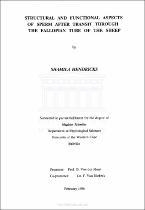| dc.description.abstract | Ejaculated mammalian spermatozoa have the potential for fertilization. The acquisition of the ability to fertilize a fully invested oocyte occurs during the passage through the female reproductive tract. These post-ejaculatory maturational changes include the processes of capacitation and the acrosome reaction. The Fallopian tube has been accepted as the site of completion of these events while their initiation may occur either in the uterus or in the Fallopian tube. The role and/or interaction of the Fallopian tube with sperm to undergo these molecular events, are poorly understood. This study attempts to demonstrate the influence on sperm of the environment of the Fallopian tube which could initiate certain structural and functional alterations with respect to capacitation and the acrosome reaction; this study does not attempt to define the exact nature of the interaction between spermatozoa and the Fallopian tube. In this study the ur vivo situation is mimicked, exposing sperm to the oviduct under laboratory conditions. Pre- and post-migratory sperm were compared. The specific structural and functional aspects examined in this study include motility, morphology, localization of N-acetyl-D-glucosamine receptors and the acrosomal status. Motility is important to ensure successful migration to the site of fertilization. Special attention was focussed on the incidence of hyperactivation after transit through the Fallopian tube. The term hyperactivation has been used to describe the frantic movement of sperm before they undergo the acrosome reaction and often serves as a biological marker for capacitation. Motility analyses were performed using the CASMA system, the Sperm Motility Quantifier (SMQ). The biological state of hyperactivation occurred in a small population of spermatozoa after transit through the Fallopian tube. A morphologically normal sperm is a direct product of spermatogenesis and epididymal maturation. No gross morphological alterations have been reported to occur to sperm within the female. tract, Instead, elimination of sperm with gross morphological aberrations (whether as a direct function of the female tract or intrinsic sperm factors) has been shown. Measurement of the sperm head dimensions were performed in this study using the Flexible Image Processing System (FIPS). No obvious morphological disparities were present in the samples of ram sperm used. No obvious morphological alterations/selections occurred during transit through the Fallopian tube. Ram sperm head dimensions are defined. Fusion between spermatozoa and the egg vestments is a crucial step in fertilization. Exposure of audiogenic structures on sperm is a component of capacitation. The presence of these receptors is important in species-specific interaction and its absence play a significant role in infertility. FITC-conjugated wheatgerm agglutinin was used to identify and localize N-acetyl-D-glucosamine- like receptors on the sperm membrane surface. This surface component is believed to play an important role in sperm-egg interaction. Membrane alterations associated with receptor activity (allowing for sperm -zona binding) appear to have occurred after transit through the Fallopian tube. The acrosome reaction has, to date, been recognised as the most reliable indicator of the completion of capacitation. It is generally accepted that the acrosome reaction of the fertilizing sperm occurs at the zona pellucida surface, that previously acrosome-reacted sperm may also bind to the ZP. FITC- conjugated peanut agglutinin was selected as a probe for acrosomal status extermination. An increase in the incidence of acrosome-reacted sperm was observed after transit through the Fallopian tube. A small population of spermatozoa, therefore, appear to have acquired (wholly or partially) fertilizing potential after transit through the Fallopian tube. | en_US |

